Stay in the know on all smart updates of your favorite topics.
Mobility and transport are crucial for a city to function properly. Amsterdam is considered the world capital of cycling; 32% of traffic movement in Amsterdam is by bike and 63% of its inhabitants use their bike on daily basis. The number of registered electrical car owners in the Netherlands increased with 53% to 28.889 in 2016. Since 2008 car sharing increased with 376%. However, this is less than 1% of the total car use. Innovative ideas and concepts can help to improve the city’s accessibility, so share your ideas and concepts here.
Searching for early adopter for Smart city traffic system!
With 45 Actibump installations in Sweden and 7 in Australia Edeva are now looking for a first customers in The Netherlands.
The Actibump is a dynamic speed bump. In combination with the web service EdevaLive (SaaS) this a real Smart City System.
Besides safe and accessible pedestrian crossings the system generates loads of data in real time.
We are offering the first customers to rent the system during a test period.
Please read more at http://www.actibump.com and get in touch with david.eskilsson@edeva.se to get the offer!
The test-site we’re looking for has the following properties:
• Speeding issues
• >2000 vehicles/day
• Pedestrians and/or cyclists crossing
• Speed limit 50 km/h or lower
• On an active bus route
There is no upper limit on the number of vehicles per day. There is also no upper limit to how heavy the heavy traffic may be. If the road can handle the load, then so can the Actibump.
RESILIO - Amsterdam Blue Green Roofs
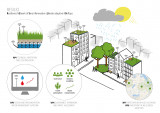
The EU-UIA funded the programme RESILIO, a project that aims to realize 10.000 square meters of blue-green roofs in four city districts in Amsterdam. The consortium of both public and private partners aims to build an interconnected network of smart roofs, in which sensors and state-of-the-art equipment enable micro-water management on rooftops. This contributes to urban climate adaption and resilience, and can potentially evolve into a scalable solution for water management on rooftops.
This project is co-financed by the European Regional Development Fund through the Urban Innovative Actions Initiative.
Job offer: operations officer Marineterrein Amsterdam Living Lab (16-24 hours)
Marineterrein Amsterdam Living Lab is een samenwerking tussen de partners AMS Institute for Advanced Metropolitan Solutions, Amsterdam Smart City, Amsterdam Economic Board, NEMO Science Museum en Bureau Marineterrein Amsterdam. Het belangrijkste doel van Marineterrein Amsterdam Living Lab is het realiseren van opschaalbare innovaties die steden leefbaar maken en houden. Om dat te bereiken, brengen de partners hun expertise en netwerk op het gebied van onderzoek, innovatie, stedelijke ontwikkeling en experimenteren samen op deze unieke plek in Amsterdam.
Voor het komende half jaar (september 2019 - maart 2020, mogelijk met uitloop) zoeken we een gedreven operations officer die het Living Lab operationeel gaat maken, aanvragen toetst, start met het runnen van de experimenten en zorgt voor verdere ontwikkeling van het Living Lab in samenwerking met de partners.
Interesse? Bekijk de vacature hier: https://www.marineterrein.nl/vacature-operations-officer-marineterrein-amsterdam-living-lab/
Witkar
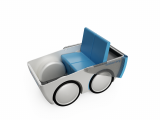
Oplossing voor first en last mile
Check the video footage from 1974:
English
Nederlands
Looking for a job opportunity
I’m enrolled in the Master’s Degree of Urban Planning and Cities Development in Strasbourg (France) and currently I’m a Research Intern on Mobility for the Brussels Studies Institute. I will graduate at the beggining of September. I really want to work in Smart Cities and Mobility , especially with my background as Urban Geographer and several experiences in France and Belgium
Future Mobility Amsterdam - 8 Concepts from California College of the Arts

As of the 1st of July 2019, Amsterdam officially began to ban the use of mobile phones while biking. How then, do we safely use navigation apps while biking? Graduate design students from the California College of the Arts Oakland asked these questions and many more during their summer program “Urban Mobility Amsterdam”. For example, one industrial design team proposed a hands free solution titled “INNATE” an Intuitive Navigation System for bike grips to connect your favorite Map app and guide you safely through the city via haptics and LED signals built into your handlebars! The students developed and presented their final concepts at Van Moof HQ on Thursday 27 June. For more information about this concept and 7 more please visit http://bit.ly/Maas-AMS
Week van Schoon Vervoer - 16-22 september
Van 16 tot en met 22 september organiseert Amsterdam de Week van Schoon Vervoer. Eén van de activiteiten tijdens deze week vindt plaats op 20 en 21 september; een groot proefritten-evenement bij het Olympisch Stadion. Maar er is zo veel meer te zien en ervaren op het gebied van schoon vervoer in de stad! Meedoen door een leuke of interessante activiteit rondom duurzaam vervoer te organiseren? Laat zien welke oplossingen er zijn, welke voordelen schoon vervoer de stad biedt of laat Amsterdammers het zelf ervaren!
Wil je zelf ook een activiteit organiseren in deze week? Bijvoorbeeld de buurt mobiliseren voor een duurzaam vervoersconcept? Met een festiviteit aandacht vragen voor het belang van duurzaam vervoer in onze stad of voor de mogelijkheden die er tegenwoordig allemaal zijn? Of Amsterdamse kinderen kennis laten maken met schone voertuigen? Laat het ons weten! We nemen dan contact met je op over de mogelijkheden om de activiteit een mooie plek te bieden in dit stadsbrede programma.
Meld je aan via: https://www.amsterdam.nl/parkeren-verkeer/amsterdam-elektrisch/nieuws/week-schoon-vervoer/
Ford in Amsterdam to Meet with Startups

The event in Amsterdam is an opportunity to hear directly from the Ford business team and to pitch your ideas before the main Challenge event in September.
On September 25-26th, the sixth annual Ford Make It Driveable Challenge will be pulling into Lisbon.
Why Attend? Pretty simple, the Challenge is an opportunity to work directly with Ford. If your submission application is accepted, you will have direct access to Ford executives, engineers, business teams as well as invited guests.
Prizes include all expenses paid trip to the Ford HQ in Dearborn, Palo Alto or London for follow up demo days as well as a trip to Mobile World Congress 2020 in Barcelona.
If you have an idea that can enhance the Connected Car or a smartphone based app, then the Ford Make It Driveable Challenge is for you!
For the full details on the Challenge and what we are looking for we suggest you check out www.makeitdriveable.com.
Get in the car with Ford!
How city data is transforming the way we live
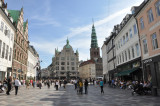
How city data is transforming the way we live
8 cities show how smart data is changing the way we live. From Las Vegas to Copenhagen, smart technology is used everywhere for an efficient, safe and pleasant living environment. How exactly does smart data management work and what advantages do new technologies have for companies and the residents of the city?
1. Las Vegas: live data
Bold, brash and operating 24-hours a day, Las Vegas is a city like no other, attracting millions of visitors a year to its bustling casinos. But as well as hosting 43 million tourists each year, the city is home to almost 650,000 residents who need services including public safety, transportation and utilities. City officials recently turned to smart city data management to ease the pressure.
They used Hitachi’s Smart Spaces and Video Intelligence solution, which is a combination of hardware and software that leverages intelligent video and other internet of things (IoT) data to provide a single view of activity, operations, and safety issues with intelligence for real-time data and analysis, deploying resources more efficiently.
For example, the city can produce heat maps of streets that can indicate if a pothole is likely to develop in a given location and take steps to fix the issue before it starts to damage vehicles. Elsewhere, rubbish collection routes have been reduced from ten hours to four, redeploying employees to help with other services.
2. Seoul: smart waste solutions
With almost ten million people living in Seoul, South Korea’s capital city, waste management has become an area of focus and, as one of the most high-tech cities in the world, it’s no surprise that big data and IoT has become part of the solution.
“Ecube Labs was founded in Seoul when the first smart city projects started to emerge in Korea,” explains Guillaume Weill, project director at Intralink. “The company’s focus is on four main products, which have now been installed in more than 150 locations in Seoul, from parks to department stores, leisure venues and tourist districts.”
These include solar-powered waste bins which compact rubbish, fill-level sensors monitoring the quantity of waste in each bin, a big data platform gathering the information from the bins and a platform that automatically refines manual collection routes based on machine-learning algorithms, bringing huge cost-savings and a cleaner city.
3. Amsterdam: 3D-printed smart bridge
With its network of canals, Amsterdam has more bridges than almost any other city in the world, around 1,800 in total. But what if smart city data management meant those bridges could talk to other infrastructure to optimise travel around the city? The MX3D bridge is the world’s first 3D-printed steel bridge designed by Joris Laarman Lab in collaboration with Arup and supported by Autodesk and other partners.
Dutch firm MX3D is using industrial six-axis robots, proprietary software and welding machines that deposit stainless steel from thin, molten wire to build the 40-foot-long smart pedestrian bridge spanning the Oudezijds Achterburgwal, one of the oldest canals in Amsterdam.
Equipped with sensors, the bridge streams data to the cloud where it is then processed and interpreted to visualise intelligence about bridge traffic, structural integrity, and the surrounding neighbourhood and environment. The bridge can send alerts when it needs maintenance and can even talk to roadways to time the lights better to reduce congestion at busy times.
"Innovative solutions ensure enormous cost savings plus a cleaner city"
4. San Francisco: smart cycles
One of the strategic goals of the San Francisco Municipal Transportation Agency (SFMTA) is to prioritise transport that doesn’t involve a car. Part of its vision for a sustainable transportation system includes a safe network of bicycle-friendly streets so people of all ages and ability can feel confident travelling on two wheels.
The SFMTA uses automated counters to monitor key bicycle data, which it analyses annually to get an idea of cycle use in the city. Using the information provided by these smart monitors, the SFMTA added ten miles to the bikeway network and created thirty new intersections. Of those new miles, 5.5 received physical protection from passing traffic.
More than eight million bikes were counted at forty locations in 2018, but the data showed 63 per cent of the weekly ridership was occurring in just seventeen of the fifty-one reporting counters. This information enables the city to focus its improvement efforts where they are needed most.
5. Stratford, Ontario: perfect parking
Parking in cities is often frustrating and time consuming. But with the help of smart city data management, it can become a much simpler affair. Seeing the opportunity, the City of Stratford in Ontario, Canada, has invested in smart technology so visitors can spend less time trawling for a space and more time spending money in local businesses.
The city has installed 78 IoT sensors thatmerge information with global positioning system, or GPS, data and relay whether a parking spot is free or empty, with updates provided every half an hour to an Amazon Web Services MQTT Broker, which relays the update to the Information Builders WebFOCUS data analytics platform. WebFOCUS then creates easily read visualisations, which convey which spaces are free where, when the busiest parking periods are, and which are the preferred car parks, levels and spaces used by residents and visitors.
6. Edam-Volendam: smart lighting
With its authentic streets and charming fishing port, Edam-Volendam is a real tourist attraction. The municipality wanted to reduce the energy bill for public lighting and at the same time ensure a safe environment for visitors and residents. The smart lighting systems from Luminext in combination with LED luminaires from Lightronics and Lightwell provide the solution.
By illuminating only where it is needed and by dimming as soon as there is no traffic on the street, Edam-Volendam saves energy while ensuring a safe environment. With the smart lighting technology in the luminaires and the telemanagement system from Luminext, the public lighting network is controlled and managed remotely.
The smart lighting ensures that the amount of light is automatically adjusted to the need for light on the street. More light in dark alleys enhances the feeling of safety and dimming the street lighting in a residential area causes less light nuisance in the bedroom, which is good for a good night’s sleep. The smart lighting system automatically detects defective lamps, allowing repairs to be started quickly and to make the lighting function well as soon as possible. That also benefits street safety. The lighting installation and energy consumption are continuously monitored to be able to dim the lighting as efficiently as possible. As a result, the energy savings are optimal.
7. Copenhagen: energy saving
With dwindling global energy supplies and the environmental impact of certain types of energy, cities must look carefully at their use. It’s unsurprising then that energy use is a huge consideration when it comes to smart cities using big data.
Frederiksberg Forsyning, a publicly owned utility company in Copenhagen, aimed to create a smart energy supply solution that would optimise their supply network and create efficiency savings. One of the issues with doing this is the reliability of data, with utility companies often reliant on customers for monthly or yearly meter readings.
To tackle this, the company created a connectivity network across the municipality and then installed sensors in their pipelines to measure usage from the point of production to the substation and on to the end-customer. They went from getting infrequent customer readings to 700 data points a second, seeing savings on water loss and energy use.
8. Brussels: Smart transport tech
The Belgian capital city of Brussels relies on four metro train lines, seventeen tram lines and fifty bus lines to get its residents where they need to go. STIB–MIVB, the company that runs these services tracks 401 million journeys a year and 1,200 vehicles. To handle the stream of big data, it partnered with SAP and Cubis to access the analytics needed to improve customer service and run the system more efficiently.
As well as improving the experience of commuters and visitors, the partnership has enabled more proactive vehicle maintenance, greater transparency when it comes to use of public funds, the ability to cater for passengers with disabilities and reduced environmental impact.
“Cities are full of data that can help us better understand travel times, routes and crunch points on a network,” says Brian Duffy, SAP’s Europe, Middle East and Africa north regional president. “If used in the right way, data insights can help people get to where they are going faster, more efficiently and more reliably.”
Sources: Luminext & ‘Future Cities’; Special editen by publisher Raconteur, international distributed with The Times in june 2019.
More information at Luminext.eu or info@luminext.eu
Event recap: MaaS Transit Getting Around Smart in Amsterdam

Imagine a future Amsterdam where personal combustion engine vehicles are a thing of the past – resigned to an exhibit in the Rijksmuseum. Laugh now, but we may be closer to that possible future than you think. WeMakeThe.City recently held a discussion on the future of travel in and around the center of Amsterdam. The prognosis? Mobility-as-a-Service (MaaS) is a way for the city to manage growth and congestion while improving the quality of life of residents. A recap of the event by our special reporter Derrek Clarke.
MaaS transit consists of both private and public transportation solutions that are consumed as a service through a single interface. Instead of personal vehicles, travellers will have their choice of shared electric cars, bicycles, scooters, trams, trains and ferries – whichever mode of transportation fits their needs.
“Multi-modal (MaaS) transit is the future of urban travel and its coming to Amsterdam.” – Miguel Gamino Jr., Head of Global Cities at Mastercard
Amsterdammers will not be forced to give up their cars immediately, but incentives are already being put in place to drive change. This summer the city has already embarked on a plan to replace around 11,000 streetside vehicle parking spaces in the urban center with more bike racks. In addition, smarter infrastructure management practices have also been piloted around the ArenAPoort area. Here drivers and public transport users are provided with transport information such as wait times, the location of available parking and payment instructions – all of which have led to 75% lower congestion in the area.
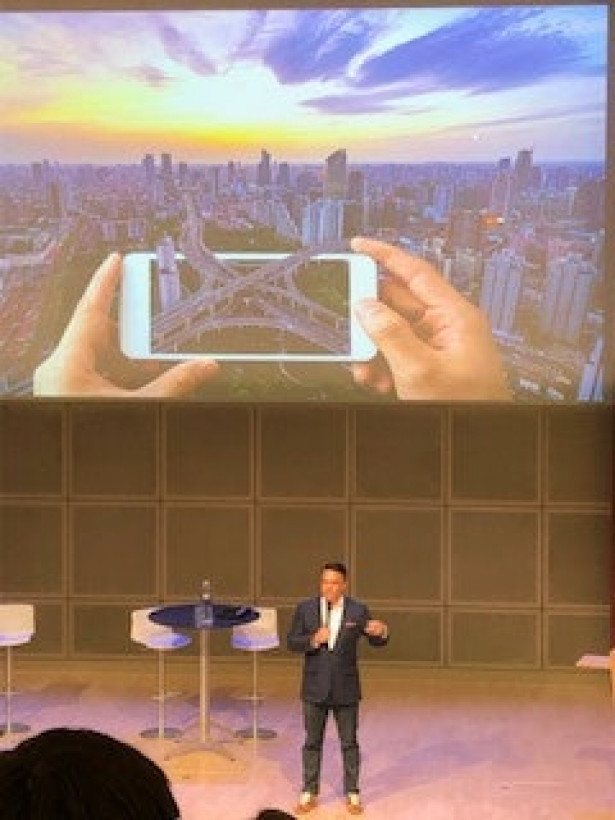
Sounds great doesn’t it? Less congestion and traffic frustrations, fewer accidents, lower costs, safer travel. Getting there won’t be easy through. As Robert Jan ter Kuile, the Strategy Officer for GVB states, “This will entail accommodating different travel needs from disparate destinations such as from rural locations to urban locations or vice versa”. This transition will require the formation of more public-private partnerships to be successful. Government agencies will need to partner with fast moving private companies to create the infrastructure to support a MaaS transit vision of the future that finds the right balance between different modes of transportation.
Envisioning Transportation Equality For All
Finding the right balance of technology to support MaaS transportation will not be easy. For example, replacing all personal vehicles or public transportation with ridesharing may create more problems than is solved. As Oded Cats, an Associate Professor at TU Delft and AMS Institute points out, “…with ridesharing, as demand increases travel time will also increase as riders have to wait longer for a car to arrive. This will lead to increased ride cancellations as people become increasingly frustrated with extended waiting times”. However, having more rideshares available will also mean that another, potentially available car will not be far away.
Increasing the number of combustion engine cars constantly roaming around Amsterdam in search of passengers will not help air quality. This is where alternative fuel vehicles such as electric or the often-hyped hydrogen fuelled cars will come into play. To be successful, service providers will need more infrastructure than what is currently provided. The current limited number of EV charging infrastructure for cars and other vehicles is hampering growth in the use of electric vehicles. Charging locations have to be more visible and frequently located to instil confidence in users that if a car is running low you won’t be stranded in the middle of a journey. Hydrogen fuelled cars are still quite far off into the future.
Investing in EV charging infrastructure will also benefit the adoption of electric buses, trams and the transition to more energy efficient buildings. Yes, you read that right, EV charging infrastructure can help make buildings more energy efficient. This is accomplished through the use of bi-directional charging. In this way, the EV charging infrastructure can act as batteries for buildings – feeding electricity back when the price is high and vehicle batteries are already fully charged. Not only will this reduce energy costs, but it will also alleviate pressure on ageing utility grids. This is a step towards being a smart city through smarter infrastructure. As Vivek Makhija, Head of E-Mobility and Advanced Biofuels at Royal Dutch Shell stated, “We will need a mosaic of energy futures moving forward (to transition to a smarter urban future)”.
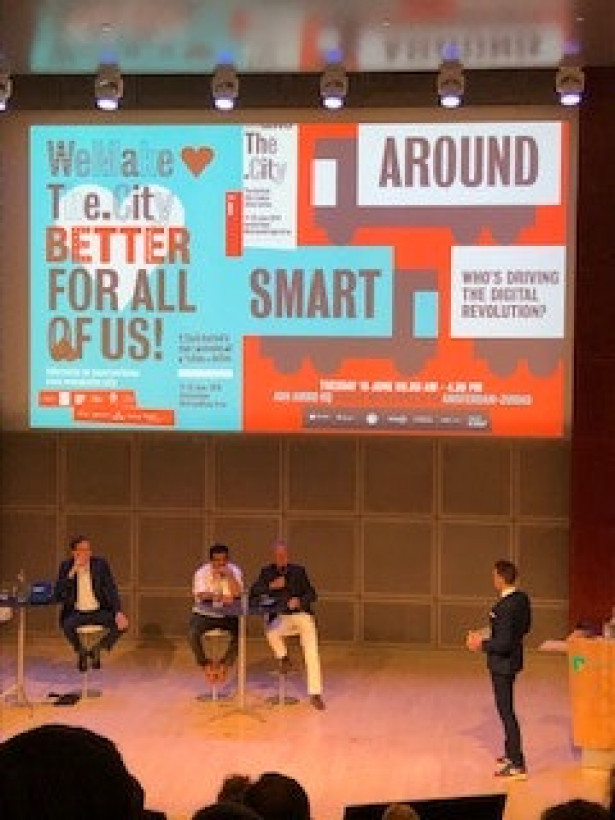
The Future Is Uncertain Until We Decide To Create It
In the end, it is up to the citizens of Amsterdam to effect change. Some 40 years ago, the people of Amsterdam, neighbourhood by neighbourhood decided to become a more bike centric society. This transition is still happening today. The same effort will be required to transition to a MaaS transit society. To get there though, we will have to answer some tough questions about ourselves. Franka Couzy, Head of Sector Research at ABN AMRO voiced some of these questions such as “Am I ready to give up my car?”, “Is there a good replacement system I can rely upon?”, “Is my expensive parking space going to become a stranded asset?”, and “How much privacy am I willing to give up for personalized transportation services?”.
To be successful, the development of a MaaS transit system is going to require the active participation of private enterprise, government agencies and private citizens working alongside each other. This is the next evolution of the problem of the commons – where we all have to pitch in to protect and support our collective environment. It’s time for change, are you ready?
Text and photos: Derrek Clarke
Smart Public Lighting in municipality of Renkum

The municipality of Renkum wants to switch to smart public lighting throughout the municipality and at the same time build an infrastructure for future Smart City applications, preferably with as few investments as possible. In response to this wish, Luminext (smart lighting), CityTec (service partner) and Primevest Capital Partners (financing) started a partnership to make this project possible.
Kevin Groen, project leader for the municipality of Renkum: “We have been busy in recent years for the tender for new public lighting. We are in need of replacement; our area is outdated and some lampposts are about to fall over. So we cannot wait until the first lampposts are replaced. We are looking forward to a great collaboration in a unique tender form!”
More information:
Please contact Mirjam Endendijk, Manager Marketing & Communications Luminext: <a>mirjamendendijk@luminext.eu</a>
Event report: Will the cities of the future be car-free?
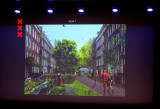
Climate change, air pollution and lack of space - issues to a lot of cities. Is the solution to become car-free? The third day of the urban festival WeMakeThe.City festival saw experts from industry, academia and government come together to discuss the future of urban mobility during the “Autoluwe Stad” conference. Read the report, written by Ellie Roy.
Rethinking the role of cars
Rogier Elshout, moderator of the conference, started by asking the audience: “What should the city of Amsterdam aim to achieve by 2040? Should the city become emission-free, completely car-free or should the government just leave things as they are?” The audience clearly favoured a city in which pollution was avoided and the role of cars reduced. Like many other cities worldwide, Amsterdam has already set a concrete goal for the future: by 2030 the city will be emission-free for all forms of transportation. In order to make this happen, sustainable alternatives to the car need to play a larger role.
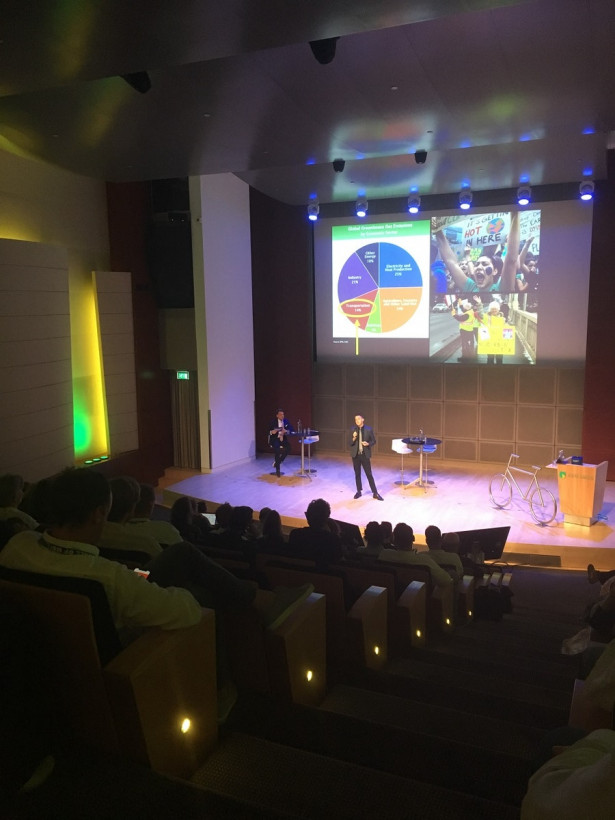
For the last decades cities, including Amsterdam, have focused on a car-centred design. Max Hirsh, research professor at the University of Hong Kong, explained how this poses a challenge: “For many people not having a car would lead to a reduction in quality of life. This issue is particularly relevant for those living on the outskirts of the city where the public transport network is more limited. This results in a phenomenon referred to as the “last mile problem” - the challenge of connecting transportation hubs with people’s final destination. While this problem persists, cars will remain the dominant mode of transportation.”
For improvements to be made, Max believes that the relationship between the car and the city needs to be reconsidered fundamentally. In order to do this “we need to start by looking at people’s desires and needs - rather than telling people how they should live. We should look at how they are living and ask them if they necessarily need a car to achieve these different tasks.” In his opinion, providing cheaper and more convenient alternatives is the solution to changing people’s behaviour. Innovations in e-commerce and logistics could play an important role. For instance, home delivery services and airport luggage collection would provide people with an alternative to transporting heavy items themselves, therefore reducing the reliance on the car.
Making car-free make sense
The City of Amsterdam is already taking steps towards reducing car dependence by investigating and implementing cleaner and smarter mobility options. Sharon Dijksma, Deputy Mayor for Traffic, Transport, Water and Air Quality, explained the city’s plans for the coming years. “We want more space and better air quality, therefore it is necessary to reduce the space for cars in the city in favour of cyclists, pedestrians and other modes of transport. In order to achieve this, a variety of new concepts are being tested. For example, in many neighbourhoods “eBuurthubs” will be developed together with residents. These are places where different types of sustainable mobility will be clustered, allowing alternatives to private car ownership (such as e-bikes and shared cars) to become more accessible.”
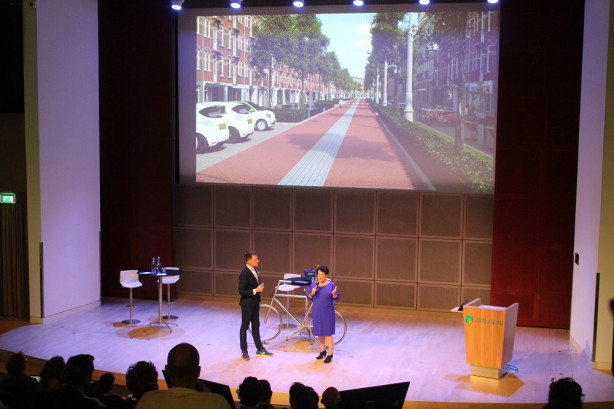
In addition, the city has conducted research into the feasibility of becoming less car dependent. A so-called “travel test” was conducted, in which 70 people handed in their car keys in exchange for a budget to spend on alternative modes of transport. Diederik Basta from Amsterdam’s CTO Office and Marije van Gent, researcher at the Hogeschool van Amsterdam, discussed the outcomes of this experiment. Diederik explained that one of the most surprising conclusions was that none of the participants finished the 500 euro budget. Furthermore, one third of the participants decided to give up their car after the experiment. Marije pointed out that most people participating in the study were already considering going car-free. However, the results illustrate that being less car dependent is definitely a feasible option.

In many cities worldwide, Uber has become one of the companies helping to make car-free alternatives become more feasible. More than just a taxi company, Uber is expanding its services to include sustainable mobility options. Thijs Emondts, general manager of Uber Benelux, presented the company’s new vision. “Ultimately taxis and cars were just the start, the strategy is to become a platform for all forms of mobility”. Ride shares, e-bikes and public transport will all be incorporated into the platform. An entire journey could be made using one app, allowing sustainable alternatives to become easily accessible. This type of service could provide the city with many benefits. Sharon Dijksma was clear to emphasise the importance of policies to regulate new services, particularly in relation to data collection and privacy. “Anyone offering mobility services in the city also needs to be held accountable”.
Greener streets
Of all of the initiatives presented during the conference, one of the most striking was the redevelopment of the Frans Halsbuurt, initiated by residents of the neighbourhood. The Frans Halsbuurt is an area in Amsterdam characterised by narrow streets and many pedestrians and cyclists. Residents put pressure on the local municipality to remove all parking spaces and redesign the public space to create a better living environment. Peter Ulle, senior designer for the project, explained how collaboration with the residents was made a priority and used to establish the starting points for the design. A rough sketch of what the area might look like in 2020: an impressive vision of green public space. It made the audience wonder: is this what the car-free city will look like...?
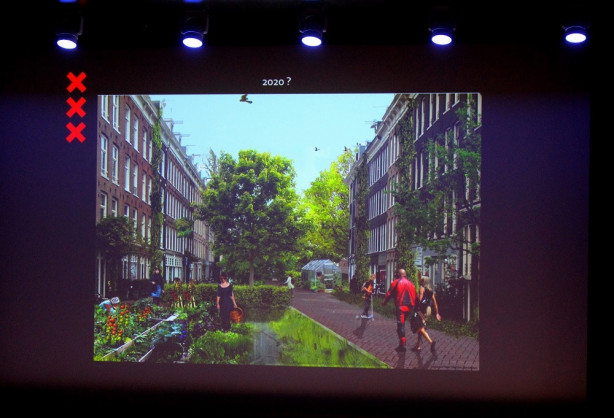
Text and photos: Ellie Roy
Start Smart Mobility Amsterdam 2019 - 2025
An accessible, liveable and less polluted city: this is what we’d like to achieve for residents, visitors and businesses in Amsterdam today and for future generations.
Smarter and cleaner mobility can help us realise these aims. As a city, we want to offer Amsterdammers, commuters and visitors alternatives to the present forms of mobility, providing a door-to-door solution and contributing to our aims. This includes shared electric transport, from cars to bikes, in ‘Neighbourhood eHubs’ (eBuurthubs) established in cooperation with local residents. That way, we can use clean modes of transport and create more space in the city by sharing. We can then use this extra space to improve liveability.
More info on www.amsterdam.nl/smartmobility
Program Smart Mobility Amsterdam 2019 - 2025
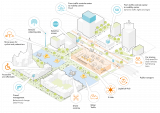
An accessible, liveable and less polluted city: this is what we’d like to achieve for residents, visitors and businesses in Amsterdam today and for future generations. Smarter and cleaner mobility can help us realise these aims. As a city, we want to offer Amsterdammers, commuters and visitors alternatives to the present forms of mobility, providing a door-to-door solution and contributing to our aims. This includes shared electric transport, from cars to bikes, in ‘Neighbourhood eHubs’ (eBuurthubs) established in cooperation with local residents. That way, we can use clean modes of transport and create more space in the city by sharing. We can then use this extra space to improve liveability.
More info and link to the program via www.amsterdam.nl/smartmobility
Check the report:
https://www.amsterdam.nl/wonen-leefomgeving/innovatie/smart-mobility
Actions
To achieve the ambitions, we will start working with two program lines:
1. Data and digitization
This program line helps the municipal organization digital tools and skills to ensure sufficient control in the future be able to rely on mobility in the city and around
improve quality in public spaces. We are working towards a mobility center of the
future. For this we will use the take the following steps:
• A shared basis: building a strong one data position
• A level playing field: frameworks
• Learning by doing: from traffic management to mobility management
• Ready for the future: aware of the consequences of digitization of mobility
2. Innovative mobility solutions
In this program we work together on concrete smart and clean alternatives to transport, so that Amsterdammers and visitors to the city are less dependent on their own car. We do this by setting up projects in certain urban areas and for specific target groups. We also focus on smart city logistics and we explore the possibilities of transport by water and air. Special attention is given to vulnerable groups and Amsterdam residents with a small grant. We improve the range of new affordable mobility concepts and increase demand, we grow into smart mobility city number 1 with a better and accessible mobility system for everyone. For this we will include the following in this program:
• Smart organization of mobility in the city: travelers are working on alternatives to possessing cars and initiating behavioral change.
• Smart fitting and efficient deployment of new mobility solutions: creating space for new concepts in the city and scaling up
• Anticipate on technological innovations: insights into new opportunities and collaborations. The report contains an overview of the various projects started in the previous program that are still running and newly started activities.
Parking Data
Hello Everyone,
I'm a Master's student at the University of Connecticut and I am doing research on the connection between available parking and mode share. Does anyone know where I can find data for the number of off-street parking spaces in the city center before 2013?
Thank you!
Liz
And the winners are...

On 16-17 June we organised, together with the City of Amsterdam, AMS Institute and EIT Climate-KIC, a 24-hour non-stop pressure cooker event. 45 participants worked in 8 multi-disciplinary team to ideate, uncover insights and propose innovative solutions to the city's urban challenges.
The 24-hours Amsterdam City Challenge is one of the events that Amsterdam organises to stimulate their citizens to come up with bright and bold ideas for a sustainable future. The challenges of this event where about Mobility and the Energy Transition:
Mobility
- How can we organize the supply of fresh food and beverages in the city, in a more efficient manner?
- How can we improve management of the mobility flows to major tourist attractions more effectively, such as the Zandvoort beach on sunny days?
- How can we increase the safety of cyclists with respect to congestion on the bike paths and roads (i.e. electric bikes, cargo bikes, and regular bikes)?
Energy Transition
- Taking the Haparandadam as a point of inspiration, how can we install solar power in unusual places?
- How can we make data centers greener?
And the winners are...
Amsterdam City Challenge - Innovate the City in 24-hours
Of course every challenge has its winners. But the compliments go to all the participants that where awake for over 24 hours! It is quite a challenge to stay awake... But during this pressure cooker, all kinds of great ideas come alive. That is the great thing about this 24-hours event.
The winner of the Mobility Challenge is team Extra Mile. They came with the idea to use the infrastructure of the trams to deliver food and beverage supplies to the restaurants and bars in Amsterdam. In order to realise this, this team introduced 'De Vreet Tram' ('Vreet' means 'eating a lot' in Dutch).
The winner of the Energy Transition Challenge and the Tada-price is Switchport. This team developed a great idea to combine art with the construction of solar panels. They also wanted to make the use of the solar panel inclusive for the citizens.
Besides winning € 1,000 to work on their ideas furthermore, the teams also got the opportunity to present their ideas during WeMakeThe.City
Level Up Your Customer Experience Through Technology

We are thrilled to be hosting our first meetup in Amsterdam focusing on customer experience and technology.
Learn how to utilize technology to better shape your customer's journey.
Join us for Interesting content, refreshing drinks and tasty bites are on us! Monday June 24th, register here:
https://bit.ly/2Wu8QHJ
Level Up Your Customer Experience Through Technology

We are thrilled to be hosting our first meetup in Amsterdam focusing on customer experience and technology. Learn how to utilize technology to better shape your customer's journey.
Do you have a novel idea that can help solve urban challenges in Amsterdam?
Join the Amsterdam City Challenge, a 24-hour non-stop pressure cooker event on 16-17 June to kick-off the WeMakeThe.City festival. These videos tell you why!
As the city becomes more densely populated, city authorities face the growing challenge of ensuring that citizens have affordable and sustainable energy and mobility options. To ensure we keep Amsterdam as a clean and healthy city, and to achieve our carbon emission goals by 2030, we want to encourage accelerated innovation and support the development of new, smart technologies. The Amsterdam City Challenge will allow you to work in a multi-disciplinary team to ideate, uncover insights and propose innovative solutions to the city's urban challenges.
Co-design sustainable urban solutions
During the 24 hours, the participants will be guided by experts from the energy and mobility sectors. At the end of the event, a panel of experts from different backgrounds will select the winning teams and award the following Prizes:
- €1000 cash for the winning team of the Mobility challenge
- €1000 cash for the winning team of the Sustainable Energy challenge
- 5 free tickets to the AMS summer school on Mobility (€200 value each)
- A wild card winner for entry to AMS Climate Launchpad
- An opportunity to pitch your idea to a large audience of the WeMakeThe.City festival during the signing of the Klimaat Akkoorden on Thursday, June 20th as well as the opportunity to present during the three Mobility Conferences.
- An opportunity to pitch your idea during the Amsterdam Smart City "Demo days," with immediate feedback from various partners and experts.
- A chance to work alongside the city officials on a "living lab" approach to your solutions.
- An opportunity to collaborate with rich, diverse networks of the City of Amsterdam, AMS Institute and EIT Climate-KIC.
City challenges you will be tackling
Energy
How can we make data centers greener? Video with Marieke van Doorninck (Deputy mayor City of Amsterdam) and Jan Duffhues (City of Amsterdam)
Amsterdam City Challenge - Heat of data centers
Taking the Haparandadam as a point of inspiration, how can we install solar power in unusual places? Video with Kirsten Dunlop (CEO EIT ClimateKIC) and Antonia Nieto Diaz (City of Amsterdam)
Amsterdam City Challenge 2019 - Energy solutions for the Haparandadam
Mobility:
How can we organize the supply of fresh food and beverages in Amsterdam in a smarter way, and with zero-emissions, in order to minimize the impact on the city streets? Video with Cathelijne Hermans (City of Amsterdam)
Amsterdam City Challenge - efficient logistics
How can we improve management of the mobility flows to major tourist attractions more effectively, such as the Zandvoort beach on sunny days? Video with Rachel Tienkamp-Beishuizen (City of Amsterdam) and Arthur Rietkerk (Province of Noord-Holland)
Amsterdam City Challenge - Mobility challenge at Zandvoort
How can we reduce congestion on the bike paths and roads during rush hour? Video with Arjan van Timmeren (scientific director AMS Institute) and Koen van 't Hof (City of Amsterdam)
Amsterdam City Challenge 2019 - Improve cycling!
So sign up!
Together we can turn the Amsterdam Metropolitan Area into a frontrunner of urban mobility and sustainable energy!
Less than two weeks until IMPACT>MOBILITY lands in Amsterdam
Hi All,
I'm writing this from a particularly wet and windy London evening as I plot my bike ride home and I thought an apt time to remind people that IMPACT>MOBILITY is now less than two weeks away!
With over 60 European cities joining us and leading mobility movers and shakers such as Bird, Uber and Lime joining us it is the essential and must-attend conference for folk looking to understand new business models and align private commercial strategies with city mobility leads.
If you're interested in joining us, don't hesitate to reach out directly.
Luke
Stay up to date
Get notified about new updates, opportunities or events that match your interests.

